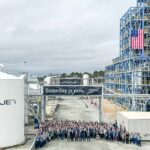Over a decade ago, algae was seen as a very promising biomass for producing jet biofuel and a number of high-profile startups attracted big-name investors. In 2009, Continental Airlines flew the United States’ first-ever commercial jet test biofuel flight that was partly powered by fuel made from oils from algae and the non-crop plant jatropha, itself touted at the time as a “wonder crop”. While jatropha‘s promise quickly disappeared, work continued on developing microalgae as a commercially-viable source for transportation fuels but projects got little further than the pilot plant stage and the startups gradually fell away, and now algae oil is confined to use in high-price bioproducts. However, a new four-year, €5 million ($5.5m) EU-funded project, FUELGAE, has been set up to look again at algae’s potential as a fuel for the aviation and maritime sectors. A consortium of 13 partners coordinated by CSIC (the Spanish National Research Council) will seek to develop a novel method for producing advanced liquid fuels from different streams of CO2 emissions from two industrial sectors through a pilot photobioreactor integrated into their infrastructure that will use selected microalgae strains.
According the FUELGAE consortium, one of the biggest obstacles for the commercialisation of processes based on microalgae is their large energy consumption that has traditionally limited their economic viability. In the project, a team from ICP-CSIC will use innovative methods that facilitate the treatment of microalgae and the separation of its components for use. These treatment methods will reduce energy consumption, making, they hope, the process profitable from both an economic and environmental point of view.
The production of advanced liquid fuels is to be achieved by developing different technologies; selective production of microalgae to obtain polysaccharides or lipids; emerging alternative treatments of microalgae biomass; innovative catalytic improvement systems from lipids and biocrude; and online microalgae sensors.
A microalgae pilot plant will be built at an ArcelorMittal steel plant in Romania and at a biorefinery in Spain. FUELGAE project technologies will be further evaluated through life-cycle analysis to confirm their lower environmental impact, resource use and GHG emissions. In addition, the project will include studies of hydrothermal liquefaction and biogas processes. To minimise by-products, the biochar produced in the hydrothermal process will be tested for use as an agricultural soil enhancer. All technologies, says the consortium, will be extended to Technology Readiness Level 5 (TRL5).
The development of chemical technologies using catalysts (materials that facilitate chemical transformations) for the conversion of biocrude and lipids into advanced fuels will also be investigated. “Such technologies are necessary for the conversion of difficult-to-handle and low-value materials into high-quality advanced fuels, which can be used in heavily polluting and difficult to decarbonise sectors, such as the air and maritime transport sectors,” says the consortium.
FUELGAE, which brings partners together from six European countries, is being led by Silvia Morales de la Rosa of CSIC. “The project represents a new approach to eliminating CO2 emissions and transforming them into advanced liquid fuels,” she commented. “Novel multi-disciplinary technologies will be developed based on the capture of CO2 from microalgae, together with studies of evolutionary adaptation of microalgae, novel biomass treatments to obtain lipids and sugars, and the development of high-efficiency multifunctional catalysts to obtain biofuels. These technologies will evolve to a subsequent scaling for their future commercialisation at the end of the project.”
In March 2022, a first-of-its-kind biorefinery opened in Istanbul, Turkey, that processes algae biomass to develop different products and technologies for multiple sectors, including fuel. Located inside the campus of Bogazici University, adjacent to the Black Sea where all the algae production takes place, the 2,500-square-metre facility has a capability to process around 1,200 tons of wet algae mass per year. The €6 million project is 85% funded by the EU and 15% by the Turkish Ministry of Industry and Technology.
In the US, the non-profit Algae Biomass Organization (ABO) believes algae has an important role to play in decarbonising aviation. “A decade ago, there was a frenzy of interest in algae for fuel that stirred up investments and lofty promises by a number of startups – all based on very exciting, but also preliminary, technical analysis of how efficiently algae could be used to turn sunlight, water and fertiliser into fuel. Unfortunately, those promises gave way to delays, then frustration and, finally, outright scepticism on whether the fuels would ever work,” posted the ABO in January 2022.
“Yet over the past ten years, the algae industry has quietly been overcoming the hurdles. There has been no single breakthrough to make headlines. Instead, dozens of new innovations across the board have improved efficiencies, streamlined processing and boosted production possibilities. The emergence of algae as a highly productive, innovative agricultural crop offers an opportunity of scalability and carbon efficiency that is poised to make a dent.”
Based on a recent resource and sustainability assessment of US-wide algae production potential, the ABO estimates over 20 billion gallons of SAF could be produced across a collection of 1,000 large algae farms.
Top photo: In 2009, a Continental Airlines demo flight was the first to use algae as a feedstock in a biofuel mix
Photo below (© RTDS Group): Consortium representatives on the FUELGAE project
















More News & Features
LanzaJet produces first next generation, ethanol-based SAF at flagship Freedom Pines refinery
European Commission announces Sustainable Transport Investment Plan to advance low-and-no-carbon fuels
XCF plans three new Australian SAF plants, while Wagner and FlyOro activate blending facility
UK government starts new consultation on SAF revenue certainty mechanism
African Development Bank and Japanese industrialist unite to explore SAF production in Africa
LanzaJet and KMG agree to progress SAF production project in Kazakhstan